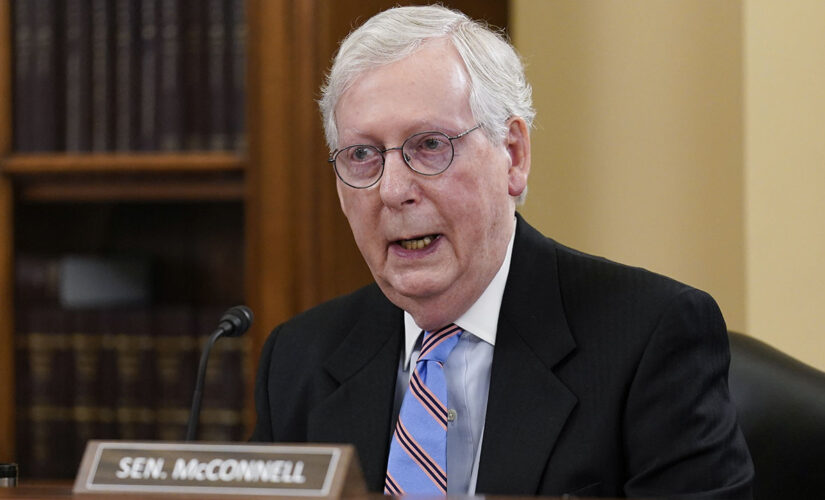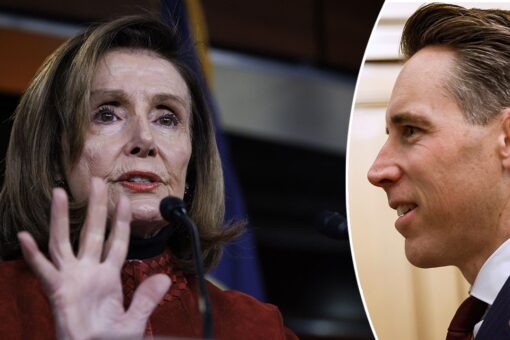NEWYou can now listen to Fox News articles!
Something surprised me last January when Democrats won both Senate runoff contests in Georgia.
Sens. Jon Ossoff, D-Ga., and Raphael Warnock, D-Ga., captured both races in upsets. Their wins propelled Democrats to 50 Senate seats. With Vice President Harris set to take office soon after, it was widely regarded that Democrats would emerge as the “majority party” in the Senate.
WILL A RED WAVE OVERCOME A BLUE WALL IN NOVEMBER’S MIDTERMS
Under the Constitution, the vice president serves as “President of the Senate,” can preside over the body, and break ties.
So, it appeared Democrats would secure the majority in the Senate, despite the 50-50 breakdown.
After all, this is what happened in 2000 and 2001. In late 2000, officials finally declared Sen. Maria Cantwell, D-Wash., the winner of a hotly-contested race over the late Sen. Slade Gorton, R-Wash. Cantwell won by 2,239 votes. That meant the Senate would be 50-50 in 2001. It took a while, but President George W. Bush finally secured the presidency in late 2000 and took office in 2001. With Vice President Cheney, Republicans would effectively hold “51 votes” in the Senate.
The same held true this time around. After some conversations and behind-the-scenes debates, Senate Majority Leader Chuck Schumer, D-N.Y, and Minority Leader Mitch McConnell, R-Ky., brokered a deal. Democrats would assume the majority. Republicans would toil in the minority. The pact would mirror the accord reached by Democrats and Republicans when there was an evenly divided Senate in 2001.
Senate Minority Leader Mitch McConnell at the U.S. Capitol in Washington, June 22, 2021. (Olivier Douliery/AFP via Getty Images)
In 2001, Republicans started in the majority – primarily because Cheney could break ties. But when the late Sen. Jim Jeffords, I-Vt., announced he would abandon Republicans and caucus with the Democrats, control of the body flipped. Democrats were then in the majority because they held more votes.
The beginning of the 117th Congress was messy. New members coming in. The horrifying aftermath of the Jan. 6 riot. The House quickly moving to impeach former President Donald Trump. The subsequent, second Senate impeachment trial of Trump. The opening days of the 117th Congress were calamitous. A crush of activity on an emotionally fraught institution.
But lots of people missed one important factor: just how quickly McConnell and Senate Republicans agreed to Democrats taking the majority to begin the 117th Congress. McConnell was OK with Democrats seizing the majority based on the 50-50 breakdown, the tie-breaking capabilities, and the precedent set by the Senate in 2000. Such circumstances dictated that Democrats would hold the majority, for now.
Coming off the cantankerous, often volatile Trump era, one may have expected Republicans to question whether the Democrats “really had” the majority. There were some GOPers who suggested the Senate really shouldn’t be in Democratic hands – despite the outcome of the Georgia Senate races and 2001 model. But there probably wasn’t much Republicans could gain by going to the mat in early 2021 as to which party held the majority.
The Senate eventually voted on and approved the resolution – which officially propelled Democrats into the “majority.” Republicans would serve in the minority.
For Republicans, there may have been an upside in playing the long game.
Democrats now control the House, Senate and White House. Democrats nearly lost the House in the 2020 elections – a phenomenon that shocked everyone. But the majority party in the Senate truly needs to show it can periodically marshal 60 votes to advance major bills.
It was one thing for Democrats to skate by with less than a handful of votes in the House. House Speaker Nancy Pelosi, D-Calif., was in charge there. Pelosi’s longtime calling card is passing major legislative initiatives with just a vote or two to spare. A tiny majority likely wouldn’t matter much to Pelosi, based on her political muscle.
But the Senate was another matter, especially with an equal Republican minority. Sure. Sens. Lisa Murkowski, R-Alaska, Susan Collins, R-Maine, Rob Portman, R-Ohio, Bill Cassidy, R-La., and a few other Republicans would periodically side with Democrats on particular issues. But Democrats had a big agenda – which didn’t comport with most of the values on the right.
The first problem was the Democrats’ $1.9 trillion COVID bill. Congress approved a major COVID bill on a bipartisan basis in December 2020 – after months of negotiations. But Democrats rallied to approve their own COVID measure in March 2021 – without any GOP help.
Republicans argued against it. They were quick to claim the bill was responsible for inflation as federal spending bulged.
Democrats then distilled the remainder of their agenda into the Build Back Better bill. Democrats argued for certain tax increases to make sure “billionaires pay their fair share.” They wanted to expand medical care to cover dental, vision and hearing. There was a push for paid family leave. Scores of environmental provisions. Such a mammoth piece of legislation proved to be a glorified press release for everything Democrats wanted so badly to accomplish.
Pelosi muscled the bill through the House, losing only the vote of Rep. Jared Golden, D-Maine. But the plan hit a brick wall in the Senate known as Sen. Joe Manchin, D-W.Va.
Republicans didn’t have to do much to respond to all of this. Any Capitol Hill veteran will tell you that while it may be more frustrating to serve in the minority, it’s easier. All members and aides need to do is lob barbs and political opprobrium at the other side.
Republicans have certainly done that. In fact, some political observers think Republicans may not need to do much to recapture the majority in the House and Senate. Democrats now hold a five-seat advantage in the House. The Senate is tied.
“Midterms are a nightmare for a president,” said Stephen Farnsworth at the University of Mary Washington in Fredericksburg, Virginia. “The midterms are generally poisonous for the party in power.”
Republicans were reeling after the losses of both Georgia seats in the early 2021 runoff. They also lost the White House. So, to Republicans, was there any upside to Democrats suddenly holding all three branches of government? In short, yes. The expectations of the left were other-worldly. They believed President Biden would deliver a liberal agenda, a la FDR. Republicans knew better.
“The left can only move as far as the most conservative member of the Democratic Caucus,” observed Farnsworth.
And so with narrow majorities, it was clear Democrats may not be able to get much done. And, if Democrats overreached, Republicans could quickly portray the president as out of step. Too liberal. Too much spending.
“The American people are not for all of this. They thought they were electing a moderate,” said McConnell to Fox’s Bret Baier. ” The president signed up for a (Sen.) Bernie Sanders, I-Vt., agenda to turn America into a socialist country.”
This is why Republicans are all but taking drapery measurements at the Capitol right now.
“I think the American public is going to be counting (down the days),” said House Minority Leader Kevin McCarthy, R-Calif., on Fox.
CLICK HERE TO GET THE FOX NEWS APP
Nothing is certain about the midterms. There is always the possibility that Republicans could trip over themselves or alienate voters. This is augmented by the looming presence of former President Trump and the potential for Reps. Marjorie Taylor Greene, R-Ga., Lauren Boebert, R-Colo., and Paul Gosar, R-Ariz., to say outlandish or offensive things.
The title of McConnell’s 2016 memoir is “The Long Game.” Two years isn’t a very long time in Congress. But some Republicans quietly concede it is better to toil in the minority for the 117th Congress. They believe a banishment to the minority may help propel them to the majority this fall.
Chad Pergram currently serves as a congressional correspondent for FOX News Channel (FNC). He joined the network in September 2007 and is based out of Washington, D.C.




